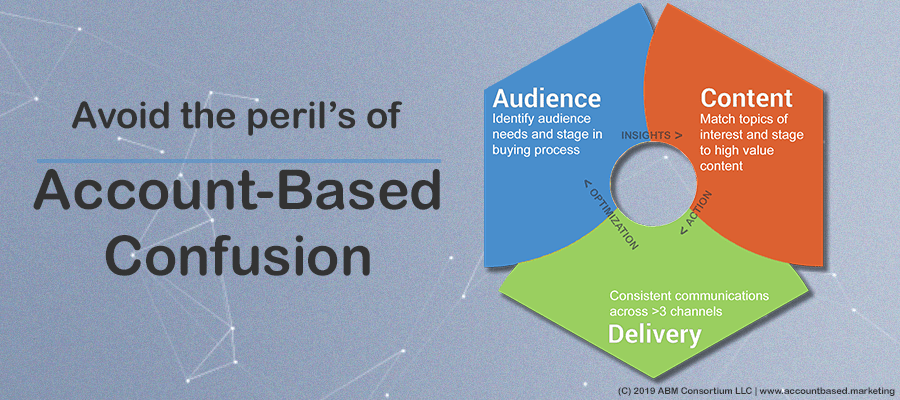Every organization has a finite audience who hear their value propositions better… find it more valuable… are willing to pay more for it… and need it faster. Simplifying the cacophony of confusion in the market, ABM is nothing more or less than the strategy to identify, target, interact, and close business those companies.
ABM isn’t a new superset of channels;
it’s an element of everything you do,
for a limited subset of companies.
Yet, with this simplicity, we estimate that two-thirds of all B2B marketing leaders have yet to find a successful path. We see that this large group consists of two key constituents: those who don’t buy into the handwaving excitement that they should select accounts and deliver ads, they know that the idea doesn’t make sense, and the other half who have to succumb to the pressure to do this and have failed, they’re trying to re-engineer their ABM program.
In a recent Oracle Marketing Cloud article, “Don’t give in to Account-Based Confusion”, my team helped me unpack the situation.
So, what comes to your mind when YOU think of ABM?
Are you supposed to select accounts based upon Intent Data or predictive analytics? If so, what do you do with all the others who will need your offering but aren’t yet in a buying cycle… ignore them?
Do you surround target accounts with campaigns coming from all angles or do you focus on display ads? For that matter, how does any of this match up with your inbound programs and nurturing? What about your sales team and their activities or learning?
Speaking of sales, how do you get your sales team involved?
Then, if your ABM program starts to produce results, what’s your deliverable to sales… leads, some type of qualification?
Oh, then after all these decisions, how do you measure success? Is it as simple as setting a rule that counts media impressions and website visits?
No, none of these are right, but all lead to one point… There’s a ton of confusion about ABM. More questions than answers. Let’s look at the priorities and challenges we all face as B2B marketing leaders…
- The three most challenging barriers to threaten ABM strategies: Measurement (connecting to revenue with “real” indicators), Coordination (between business units, with sales, and messages across channels), Agreement (Exec buy-in).
- 70% need to show impact on pipeline and revenue, and 67% need to show ROI across all marketing… yet 48% can’t track activity or measure transitions across buyer stages, and 80% simply report on media and website activity (no connection).
- 66% of marketing leaders identify personalization across customer experience as a priority… yet 86% can’t control personalization across 2 or more channels.
- Of the 18% of ABM programs that produce measurable, high revenue impact, 85% of them do three things consistently: They identify target account needs, they select content based upon those needs, they deliver that content consistently across 2.5X the channels of lower performing programs. This is the key to our research into ABM Orchestration.
- Programs that are responsive to audience needs AND this needs-based message is controlled across three or more channels produce a 251% lift in engagement.
ABM confusion looks just like marketing automation in the early 2000’s. Purchasing an automation platform was a badge of courage, and it made everyone who did this, a thought leader. The only problem… it took a few more years before the market finally digested this innovation, and what we found is that it was a strategy, and it required a lot of planning, coordination, content, and integration. And, during that time, many of the familiar platforms listened, learned, and built more mature platforms, ones that could ultimately do more of the things that people needed.
And then, we found that we needed other platforms to fix things that they either got wrong, didn’t address or were simply needed so the damn thing would work properly. I’m thinking about data, data hygiene, data integration, agency services, reporting tools… I mean, the list goes on and on.
Just like then, we were confused because best practice was not much more than a platform user guide.
Simplify
Before going all trial and error on the ABM bandwagon, go back to the basics. Much of what we do at the ABM Consortium is around this topic, solving the interest to the pilot stage of ABM adoption.
- Segmentation: Focus on separating your target accounts into groups that share basic needs. This is the strategic marketing concept of segmentation. This gives you a strong starting point for selecting audiences to pilot, it also gives you an invaluable framework for measurement: can you advance members of a segment through their buyer’s journey stages.
- Data Management: Much of what we shared in the Oracle Marketing Cloud article was around this topic. You can read a deep dive on ABM Data Management to learn more.
- Don’t boil the ocean: choose a manageable selection of segments, and a particular buyer’ journey stage (i.e. awareness issue, etc.), and segregate these accounts in your existing marketing systems. Place them in the right content flows, flag them in your campaigns and CRM. Gradually add new content and tactics to these select audiences. Measure your ability to move them from one stage to the next.


